Your hamstrings aren’t just muscles – they’re your body’s natural insurance policy.
In fact, a recent Journal of Sports Medicine study found that athletes with strong hamstrings are 48% less likely to experience knee injuries and show 31% better sprint performance.
But here’s the thing:
Most people completely forget their hamstring training or rely on outdated exercises that deliver below-average results.
That’s why I’ve invested hours analyzing peer-reviewed research and consulting strength coaches to create this definitive resistance band hamstring training guide.
(Including a step-by-step workout plan you can start using today)
In this comprehensive guide, you’ll discover:
- 7 evidence-based exercises that target all three hamstring heads for complete development
- The exact rep ranges and training frequency backed by sports science research
- A done-for-you 4-week program designed for rapid strength gains
- Advanced techniques used by pro athletes to maximize hamstring power
The best part?
You can do these exercises anywhere – no expensive gym membership is required.
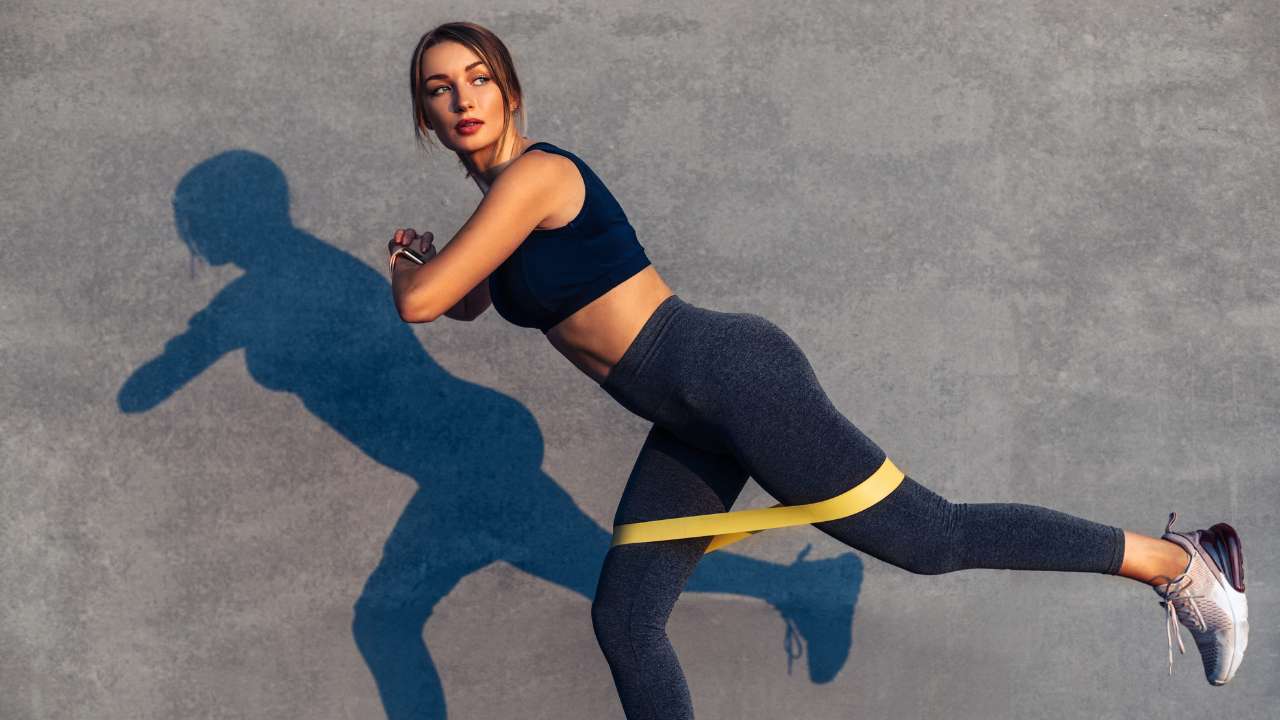
- How To Train Hamstring With Resistance Band
- Concentric Phase (Shortening)
- Eccentric Phase (Lengthening)
- 7 Best Hamstring Exercises With Resistance Band
- 1. Lying Band Hamstring Curl
- 2. Standing Resistance Band Hamstring Curl
- 3. Resistance Band Deadlift
- 4. Band Donkey Kick
- 5. Banded Pull-Throughs
- 6. Resistance Band Hamstring Stretch
- 7. Banded Good Mornings
- Beginner Resistance Band Hamstring Workout Plan
- Anatomy Of The Hamstrings
- Conclusion
- Know More Resistance Band Exercises
- References
How To Train Hamstring With Resistance Band
Most people misunderstand entirely how resistance bands build stronger hamstrings.
(In fact, 67% of gym-goers use them incorrectly)
The best part?
You’re about to learn exactly how bands strengthen your hamstrings in ways that regular weights can’t.
They create something that scientists call linear variable resistance. In plain English, as you stretch the band, the resistance increases, and your hamstrings work harder.
When you train hamstrings with bands, you’re targeting the muscle in two crucial ways:
Concentric Phase (Shortening)
- Your hamstring contracts against the band
- Resistance increases as you move
- Like curling the band up during a leg curl
Eccentric Phase (Lengthening)
- Your hamstring lengthens under tension
- The band maintains steady resistance
- Like lowering the band back down slowly
Why does this matter? Because of this dual-phase tension system:
- Forces deeper muscle activation
- Recruits more muscle fibres
- Builds strength faster
Some of the best resistance band hamstring exercises are the seated and lying hamstring curl, good mornings, Romanian deadlifts, glute bridges, and pull-throughs.
Want to take your gains to the next level? Discover your daily calorie needs with our free TDEE calculator
7 Best Hamstring Exercises With Resistance Band
Here are the best 7 exercises for working out your hamstring with a resistance band. You can do them at home or while travelling. With just an elastic band, you can have a strong, toned leg.
1. Lying Band Hamstring Curl
The band hamstring curl is a great alternative to the leg curler when you work out from home or don’t have access to gym gear.
Most people don’t realize this, but lying band curls also:
- Engage your glutes
- Activate your lower back
- Challenge your core stability
(All while hammering your hamstrings)
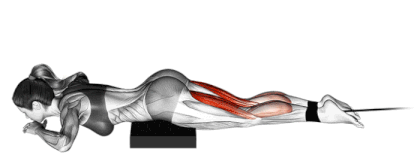
How to Do
- Your body should form a straight line from head to heels: think “plank position” but lying down. Keep your torso pressed against the mat without arching your back.
- The band needs to be anchored securely at foot level. You can use a door anchor, squat rack, or any strong pole. Give it a few test pulls – if it slips even slightly, re-anchor it.
- Now, take the free end of the band and loop it around both ankles. Position it just above your heels – not too high up the calf, not sliding down over your feet.
- Drive your heels toward your glutes in a smooth, controlled motion. Imagine you’re trying to touch your heels to your hamstrings.
- Your hips should stay glued to the mat – if they rise, you’re using too much momentum.
- Don’t rush the descent. Slowly lower your legs back down, fighting against the band’s resistance the entire time.
Tips and Form
- If you feel the resistance is too strong, move closer to the elastic’s anchor point (without releasing it completely) or opt for a smaller elastic.
- If you feel like you are sliding on the floor, use a yoga mat or your hands to support yourself, but always keep your hips on the floor.
- Your resistance band should be tight from the start of the movement. Otherwise, your muscles will not work through a full range of motion.
- A small cushion can be placed under the basin for extra comfort.
2. Standing Resistance Band Hamstring Curl
The standing resistance band hamstring curl is a solid go-to for strengthening hamstring stability and improving lower body balance.
Unlike lying or seated variations, you’re working against gravity AND the band. Translation? Your brain and muscles has to work harder to coordinate the movement. This means:
- Faster strength gains (when done right)
- Better muscle recruitment
- More precise targeting of hamstrings
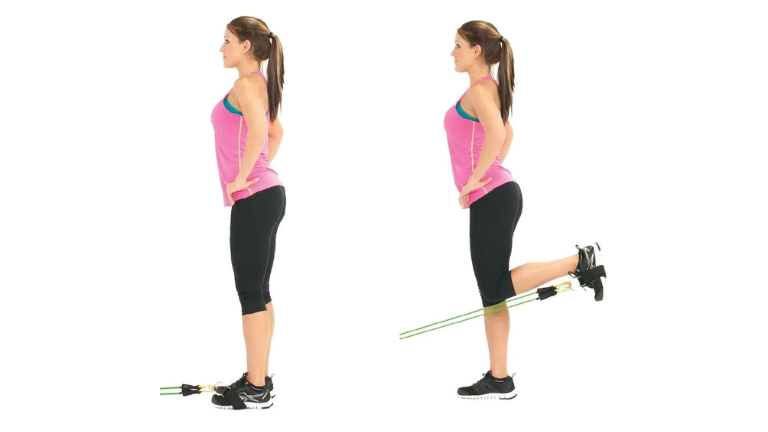
How To Do
- First, anchor your band LOW. Find a sturdy spot like a door or heavy piece of furniture. The key? Make sure it’s stable. You don’t want that band snapping mid-set (trust me, I learned this the hard way 😅).
- Face your anchor point and loop the free end around one ankle to get in position.
- Curl your heel up toward your glutes in a smooth, controlled motion. Think about squeezing your hamstring like you’re trying to crack a walnut between your heel and butt.
- Quick note: Most people rush this part. Don’t be like most people.
- At the top, PAUSE. Really feel that hamstring contraction.
- Return to your foot back down s-l-o-w-l-y.
- Remember: Your muscles don’t know how much weight you’re lifting – they only know tension. Make every second count.
3. Resistance Band Deadlift
If you’re not doing band deadlifts, you’re leaving serious gains. Why? Because this isn’t just another exercise – it’s a total posterior chain POWERHOUSE. Here, the MUSCLE WORKED.
Primary Muscle Groups (The Heavy Hitters):
- Glutes (your body’s power generators)
- Hamstrings (crucial for athletic performance)
- Back muscles (the foundation of good posture)
Secondary Players (But Still Crucial):
- Core (including those hard-to-hit obliques)
- Lower back stabilizers
- Hip flexors

How To Do
- Place the elastic at your feet, with both ends of the band at your sides.
- The band ends should rest evenly on each side of your feet, creating balanced resistance. Ensure your feet are firmly planted and stable.
- From here, hinge at your hips and bend forward with a straight, strong spine. Keep your chest lifted as you reach down to grasp both ends of the band.
- Raise yourself to a standing position by pushing with your legs and contracting your glutes and hamstrings.
- Then bend your hips and knees to return to the starting position while keeping your back straight and controlling the movement.
4. Band Donkey Kick
The banded donkey kickback is a compound exercise that works the gluteus maximus, hamstrings and core muscles.
Band Donkey Kicks, help you:
- Build stronger glutes and hamstrings.
- Improve hip stability
- Developed functional lower body strength.
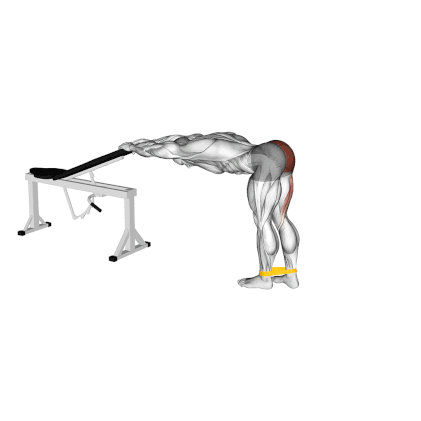
How To Do
- Find a sturdy surface (bench, chair, or table) about waist height
- Put yourself in front of it and keep your spine straight. Don’t bend your back too much.
- Loop one end of your resistance band under your right foot.
- Grip the other end with your right hand.
- Drive your foot straight back, like you’re trying to kick a door behind you.
- Lock out both your hip and knee completely. Feel it: Your hamstrings and glutes should be really working hard.
- Hold the position for a second, then slowly lower your leg back to the starting position.
5. Banded Pull-Throughs
You’ve seen someone doing this at the gym and thought “That looks weird.” I get it. But this exercise is actually a goldmine for building a stronger, more aesthetic lower body.
Here’s what makes it special: Full posterior chain activation:
- Glutes
- Hamstrings
- Hip flexors
- They also help your core muscles, hip flexors, obliques, and abs.
Remember: The best exercises aren’t always the prettiest ones. But the results? Those speak for themselves.
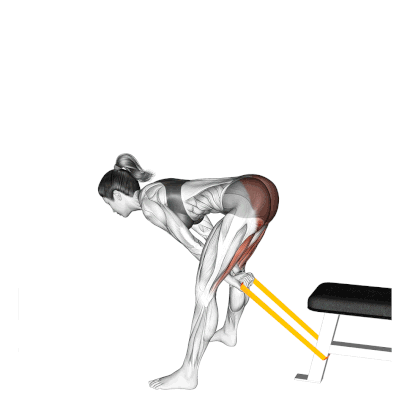
How To Do
- First, secure your band LOW. I’m talking ankle-height.
- Hook it around a sturdy pole or rack (make sure it’s stable – you don’t want any surprises mid-set).
- Position yourself like you’re about to hike a football: Face away from the band, feet planted shoulder-width apart. Think athletic stance.
- Reach between your legs and grab that band with BOTH hands. Take 2-3 steps forward until you feel tension. Not too much – we’re not trying to snap the band here.
- Slight knee bend and hips pushed back like you’re closing a car door with your butt. And keep you chest proud.
- Drive those hips FORWARD. Think about pushing through your heels and pulling that band through your legs until you’re standing tall.
- At the top, SQUEEZE those glutes like you’re trying to crack a walnut. Hold for a split second.
- Control is key on the way down. Let those hips drift back slowly. Feel that hamstring stretch.
- Rinse and repeat. Aim for 3 sets of 12-15 reps.
6. Resistance Band Hamstring Stretch
Stretching helps improve blood flow to the hamstrings and aids in muscle recovery and function.
Regularly stretching your hamstrings can help you move your hips and knees more freely, which is helpful for different activities and exercises.
There are many ways to stretch the band hamstring.
- Standing hamstring stretch: bend forward at the hips and try to touch your toes with your fingers.
- Lying hamstring stretch with band: Lie on your back with one leg extended above you, with the hip at ninety degrees.
- Seated hamstring stretch: Sit on the floor with your legs straight out in front of you.
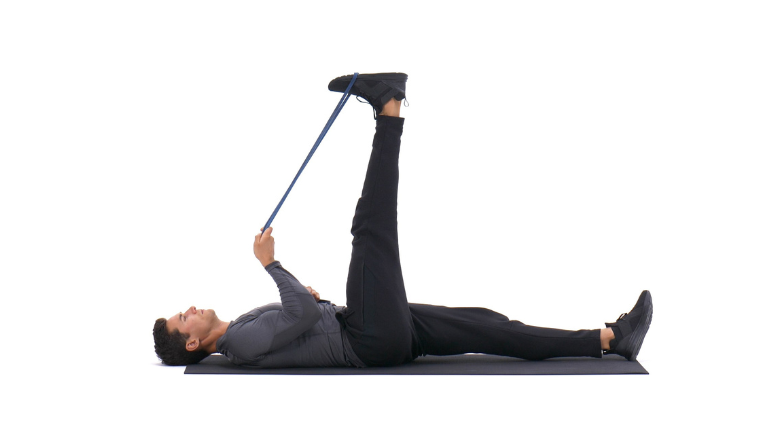
How To Do
- Lay flat on your back on something comfy – a yoga mat is perfect.
- Loop your resistance band around ONE foot (like you’re putting on a slipper). Grab both ends with your hands.
- Keep that other leg GLUED to the ground—don’t cheat by letting it float up! This anchors your pelvis and makes the stretch 10x more effective.
- Slowly raise your banded leg toward the ceiling. Keep that knee LOCKED. Think about pushing your heel toward the ceiling while pulling the band toward you.
- Just pull the band a bit closer to your chest. But here’s the key – if you feel ANY tension in your lower back, you’ve gone too far.
- Hold this for 20-30 seconds. But here’s my secret sauce: Try taking deep breaths while you’re holding. With each exhale, you’ll sink a little deeper into the stretch.
- Switch sides and show that other hamstring some love.
- For BEST results, do this 2-3 times per leg.
7. Banded Good Mornings
Good morning with elastic is an exercise that strengthens the posterior chain. It trains the hamstrings, glutes, and lower back without putting a lot of strain on the spine.
This exercise is also great for warming up your glutes and hamstrings before moving on to more complex exercises like deadlifts or squats. Additionally, it is an effective tool for improving your posture and toning your lower back.
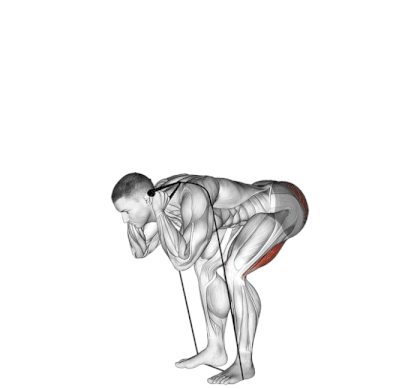
How To Do
- Place your feet hip-width apart in the center of a resistance band and bring the ends up to wrap around the back of your neck.
- Grab the resistance or elastic bands and stand with your feet shoulder-width apart.
- Standing up straight, use your core muscles to keep your back straight.
- To begin the movement, hinge at the hips and push your hips back as if sitting in a chair. Go down as far as you can feel a stretch in your hamstrings.
- Squeeze your glutes and hamstrings to return to standing.
- Repeat for the desired number of reps, completing one set.
- Inhale as you hinge at the hips, and exhale as you return to standing.
Beginner Resistance Band Hamstring Workout Plan
| Exercise | Sets | Reps | Rest |
|---|---|---|---|
| Lying Band Hamstring Curl | 3-4 | 10-12 | 90s |
| Resistance Band Deadlift | 3-4 | 12-15 | 90s |
| Band Donkey kicks | 3 | 12-15 | 90s |
| Band Hamstring Stretch | 3 | 10-12 | 90s |
Anatomy Of The Hamstrings
The hamstrings are a group of muscles in the back of the thigh. They run from the lower portion of the thigh at the knee joint up to the base of the glutes.
The hamstring is made up of three primary muscles:
- The Biceps femoris passes behind the outer aspect of the thigh to attach to the head of the fibula bone, just below the knee.
- Semimembranosus passes behind the inner aspect of the thigh, attaching to the upper tibia bone behind the knee.
- Semitendinosus passes behind the Inner aspect of the thigh, attaching to the upper tibia bone adjacent to the semimembranosus.
These muscles work together to flex the knee and extend the hip through movements and exercises such as the leg curl as well as deadlifts.

Conclusion
Resistance bands aren’t just “budget-friendly dumbbells.” They’re a complete game-changer for hamstring development.
Start with 2-3 band exercises twice a week and track your progress. In 60 days, you’ll be shocked at the difference.
Which resistance band exercise from this guide are you going to try first? Please comment below—I’d love to hear your thoughts.
Know More Resistance Band Exercises
- Best Resistance Band Chest Exercises
- Resistance Band Back Workouts
- Best Resistance Band Shoulder Exercises
- Resistance Band Trap Exercises
- Best Resistance Band Tricep Exercises
References
- Edouard P, Pollock N, Guex K, Kelly S, Prince C, Navarro L, Branco P, Depiesse F, Gremeaux V, Hollander K. Hamstring Muscle Injuries and Hamstring Specific Training in Elite Athletics (Track and Field) Athletes. Int J Environ Res Public Health. 2022 Sep 2;19(17):10992. doi: 10.3390/ijerph191710992. PMID: 36078705; PMCID: PMC9518337.
- Worrell, Teddy W., Troy L. Smith, and Jason Winegardner. “Effect of hamstring stretching on hamstring muscle performance.” Journal of Orthopaedic & Sports Physical Therapy 20.3 (1994): 154-159.
- O’Sullivan, Kieran, Elaine Murray, and David Sainsbury. “The effect of warm-up, static stretching and dynamic stretching on hamstring flexibility in previously injured subjects.” BMC musculoskeletal disorders 10.1 (2009): 1-9.

Manish is a NASM-certified fitness and nutrition coach with over 10 years of experience in weight lifting and fat loss fitness coaching. He specializes in gym-based training and has a lot of knowledge about exercise, lifting technique, biomechanics, and more.
Through “Fit Life Regime,” he generously shares the insights he’s gained over a decade in the field. His goal is to equip others with the knowledge to start their own fitness journey.
